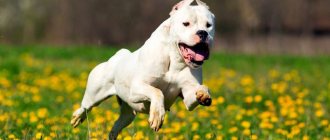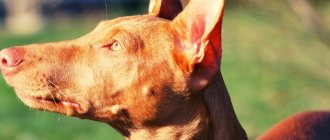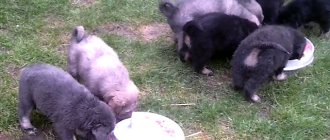The character of a dog depends on heredity and breed characteristics, but proper upbringing and training is also of no small importance. In this article we will tell you about the natural characteristics of the breed and how to properly start raising and training your pet.
The Tibetan Mastiff is a giant dog breed, one of the oldest dog breeds native to Tibet. In Tibet and throughout China it is considered a “sacred animal”. A dog of impressive size and the appearance of a lion with a steely character. The Tibetan Mastiff is strong, brave and has retained the wild habits of its ancestors. He is a fearless guard who will be the first to attack the enemy. They are aggressive towards strangers, but loyal to their owner and his family.
- Country of origin : China (Tibet)
- Height at withers : male: from 66 cm, female: from 61 cm
- Weight : male: from 60 kg, female: 50 kg
- Lifespan : 12-15 years
- Use : Security, Companion Dog
Content
- The main character traits of the Tibetan Mastiff: female or male?
- Character of the Tibetan Mastiff
- Basic commands
- Raising a dog
In this article you will learn what features of character and behavior are inherent in the Tibetan mastiff. After studying this information about the temperament and disposition of the Tibetan Mastiff at different ages, you will get an idea about the breed. Find out how the character of a bitch differs from the behavior of a dog. We hope our article will help you figure out which gender of puppy is best for you.
What does the price depend on?
There are many factors that influence the price of a representative of this breed: pedigree, color, origin and features of keeping the dog. The most expensive puppies will be representatives of the exhibition breeding pedigree, in which the breeders spent money on special food for the mother carrying the puppies, giving birth, as well as their raising and vaccination.
Representatives of Chinese ancestry are distinguished by their high cost ( more than 100 thousand rubles ), distinguished by black or red wool, as well as tan color of the mane. The price of a mastiff of European blood will range from 40 to 80 thousand rubles .
The main character traits of the Tibetan Mastiff: female or male?
The Tibetan Mastiff puppy is an active and restless pet. If you take care of and train your puppy, you can avoid pampering. Constant damage to things does not indicate the baby’s bad character, he is just very active and needs somewhere to throw out his energy. You can buy toys for him, he will be active with them, direct his energy to playing with them. Already from 3-4 months (the time of socialization), he is able to perceive the general rules of education. At this time, it is important to begin socializing and training the dog.
Breed Features
A lion's thick mane, a massive body, a large head and an absolutely pretty look: in front of you is a dog from which it is impossible to take your eyes off - the Tibetan Mastiff. The oldest type of breed that served as a guard in Tibetan monasteries. A calm, kind dog who can be part of a friendly family, treat his owners and children kindly, and guard the house with dignity.
Thanks to its dense coat, the mastiff can live freely on the street and easily tolerate low temperatures even without a kennel. Unlike other dogs, a mastiff is unlikely to run fervently to catch a thrown ball or stick: he is independent of his owner, although he is loyal to him. This breed was bred to protect humans and their homes, so the dog prefers to stay awake at night and sleep peacefully during the day.
The mastiff is smart, majestic, reacts adequately to other people’s aggression, but requires respect for one’s own person and an understanding of canine psychology. If you have never owned a dog, then you should prepare to raise this breed: a mastiff will grow up to be a wonderful dog with systematic training and proper attention to the process of its socialization. Otherwise, the dog becomes unpredictable and suspicious of strangers.
Bitch: character
There is an opinion that Tibetan Mastiff females have a more submissive and gentle character. But experts believe that character largely depends on heredity and individual characteristics. There are always exceptions, bitches with a very difficult character, and there are males with an easy-going and submissive character. But still, there is a difference in the behavior of the sexes. There are advantages and disadvantages for female and male genders.
Advantages:
- Strong relationship with owner and home
- Emotionally sensitive perception
- Girls are smarter and smarter than boys
- Accepts training tasks well
- During walks, he runs less in the bushes
- Doesn't rush at strangers
- The breed is ideal for breeding, just one assessment from the exhibition is enough
Flaws:
- Sly
- Periodic menstruation
Breed standard
The Tibetan Mastiff dog is large, very strong and tall. She has the most powerful bones, a physically powerful body and a serious character. Sexual dimorphism is well expressed - females are significantly inferior to males in weight and height. The height at the withers of the former is from 55 to 61 cm, and of the latter – from 63 to 67 cm. The female weighs from 50 to 53 kg, the male – from 58 to 63 kg.
The muscles on the body are dry and elastic. The back is flat, but there is a sharp transition to the lower back. The slightly sloping croup also has powerful muscles. The neck is short and has a large dewlap. The withers are also perfectly defined. There is a dense scruff.
The sternum is deep. The ribs can be easily felt, but they are not visible due to the thick coat. The set of the tail is medium in thickness - high. According to the standard, he should lie on his back. The dog's peritoneum is tightened. The legs are compact, spaced at an equal distance from each other, resting on pads.
The dog's head is large, the skull is wide. Sometimes shallow wrinkles form on the forehead. The older the individual, the more the fold of skin sags above its eye. The muzzle is square in shape, with a large nose at the tip. A powerful jaw with tenacious sharp teeth.
The bite is straight. The ears are small, rounded at the ends. When the animal is excited, they straighten a little on the cartilages. According to the standard, a representative of the breed must have sagging cheeks, they are moist and thick. Pigmentation of the gums is black and pink.
The Tibetan Mastiff in the photo looks like a miniature lion. He is as strong and fluffy as the king of beasts, and also has a scruff. The dog's coat is long, thick, and has insulating properties. According to the standard, it must be straight; waviness is extremely undesirable. The dog moves confidently and smoothly. There is a sense of strength and greatness in every step she takes. Her step is sweeping. Acceptable colors:
- Black and yellow.
- Black and red.
- Coffee.
- Gray or silver.
- Sable.
- Pale yellow.
- Red-red.
It is important that the animal’s fur is shiny and clean, that is, without any marks. The presence of a small light spot on the sternum is not considered a defect.
Male: character
Advantages:
- High performance, very durable
- Solid appearance, a big plus for exhibitions
- Persistence in achieving results in the learning process
Flaws:
- Independent and more stubborn than a girl. Requires more strict training than a girl.
- To fulfill your physical and natural needs, you need a longer time for walks. According to physiology, he is not capable of quickly emptying the bladder.
- Can run away from its owner if it smells a female in heat.
- During the period of estrus in females, fights with other males are possible.
Is it possible to influence and correct the character of the Tibetan Mastiff?
Raising and training a Tibetan Mastiff is of great importance, as soon as you bring him into your home. Do not allow people to chew things, stop attempts to pester strangers while walking, do not allow them to eat from someone else’s hands, pick up food from the floor, or beg for food from you while eating. It is forbidden to jump on and bite people, even to show your love. Only training and proper upbringing will change a dog’s character for the better. The puppy training process is based on the method of motivation, encouragement and praise. It is prohibited and unacceptable to treat the dog harshly during training.
How to raise a Tibetan Mastiff puppy
If you train your pet correctly, then over time you will get an obedient dog that will follow all commands and delight you every day. Experts believe that several factors may influence the Tibetan Mastiff’s susceptibility to following various commands:
- pet's temperament - the speed of the pet's reaction to stimuli, both positive and negative;
- character - how exactly the dog resists various unpleasant influences;
- obedience - the dog’s ability to accept human leadership;
- vigilance - the speed with which the dog notices potential danger, both in relation to itself and in relation to the owner;
- aggressiveness - the pet’s ability to react hostilely to potential danger;
- curiosity - interest that is developed when a dog feels, hears and sees something;
- sociability - the ability to interact with people;
- possessiveness is the interest shown by animals in certain objects, for example toys.
How quickly your dog will learn commands depends on what specific traits predominate in the character of a Tibetan Mastiff puppy. By paying attention to the character traits of your animal, you can find an approach to it and adjust its behavior in certain situations.
- Eagerness will get you nowhere . You should not try to teach a Tibetan Mastiff puppy all commands at the same time; you need to learn the commands one by one. You need to have patience and act methodically. You should not scold your pet at the moment when he makes mistakes, and when he succeeds in something, then the pet should be encouraged.
- Don't hit . It is prohibited to use physical punishment against a pet. You should limit yourself to variable intonation, but avoid shouting. Once the Tibetan Mastiff puppy is three months old, it is allowed to use a light spank as punishment while saying the phrase “Ew.” It is necessary to punish immediately when the animal commits an offense, and not after it, since the animal simply will not understand what exactly it was punished for.
- Subsequence . The main goal is to ensure that the pet follows the command the first time. Commands should be pronounced clearly and in an even voice so that the dog understands and obeys you. All family members should be involved in raising the dog, but they must act together. It is forbidden to allow situations in which you scold the puppy, and another family member praises him or simply does not pay attention.
- Pamper . Remember to reward your Tibetan Mastiff puppy with a variety of treats and praise when he has done what is asked of him.
Basic commands
You will use some commands more often, others less often. But they will still come in handy to easily interact with the Tibetan Mastiff and even keep him safe in various situations.
- Aport. One of the most difficult teams. Many people perceive it as very easy and simple, but with many dogs you will have to work hard. This skill is used for other exercises: searching, searching, selecting an item and many others. Usually they are all used in service. When working out a command, “Aport” and “Give” are used, and a gesture is also used.
- Give. On the command “Give” the dog must give up the object.
- Lie. A connecting command that needs to be learned for other commands. In addition, it will not interfere at home or on the street.
- To me. You will need to use this command quite often. So start with it immediately after your Tibetan Mastiff puppy has learned his name. Never call the dog to punish, and do not scold if it comes on its own, even after mischievousness before it. This behavior on your part may alienate the animal.
- Place. A puppy or an adult dog must clearly know where his place is located. He can sleep anywhere, if you allow it, of course, but he must know this command. You can use it outside the home, marking the place with a leash or your favorite toy.
- Near. It is possible to teach your pet the “Near” command at any age, be it an adult dog or a small puppy. When you move to a new home, you should immediately think about training your puppy.
- Sit. One of the very first commands that a Tibetan Mastiff puppy should learn.
- Stand. The command is useful in everyday life, for example, for combing a dog.
- . The prohibiting command is one of the most mandatory and taming it begins from the first day the puppy appears in the house. Requiring the command “Fu!”, “No!”, “No!” - immediately stop the unwanted action.
Care and maintenance
When you look at a huge fluffy dog, it’s hard to think that he will settle comfortably in an apartment. Of course, the ideal housing option for him is street. Guard dogs from the group of service dogs are mainly owned by owners of private houses who have a large plot of land and valuable property. For those who live in an apartment, it is better to get a small dog, for example, a Yorkshire terrier or a Maltese.
There is no need to worry that a dog with a lion's mane will freeze in winter when spending the night outside. It has a dense undercoat and long fur that protects against severe frosts. But in the summer, such a “fur coat,” on the contrary, is very disturbing. Therefore, we recommend equipping an enclosure for your large pet on the site. It should be located near the gate.
By the way, about fencing the site. In a house that has a large guard dog like a mastiff, we recommend installing a high gate that he cannot jump over or break. The booth that will be built in the enclosure should be large and comfortable. You can cover it with something soft or just put hay on the floor.
Since a representative of the breed does not tolerate heat very well due to its long and insulating coat, in the summer it can overheat while being outside. Therefore, if the home space allows it, on especially hot days we recommend letting it into the house, but only into the hallway.
Of course, the dog's fur requires special care. It should be thoroughly combed with a brush or iron comb, the main thing is to remove the tangled hairs. If the mastiff's hair is not combed regularly, it will lose its attractiveness and stop shining. You should also definitely wash them with shampoo, 2 to 4 times a year, no more often.
The animal's teeth are cleaned of plaque with a regular brush or laser. The second method is more expensive and requires patience. Large dogs become very anxious when they find themselves on the veterinarian's couch. And laser teeth cleaning makes them uncomfortable. It is not necessary to trim the mastiff's claws, since he moves a lot and grinds them down on his own. But you will definitely have to treat his fur for fleas.
Raising a dog
Education is the process of shaping the behavior of a Tibetan mastiff acceptable to the owner, when this behavior is not regulated by commands.
During upbringing, a dog develops relationships with its owner, family members, passers-by, behavior in the house, on the street, and relationships with other dogs. The training process begins immediately when the dog first appears in the house and continues throughout the dog’s life. Regardless of the dog's breed, it must be trained. Just as people do not like ill-mannered people, dogs should also know what is allowed and what is not allowed. Raising a dog is a rather complex process, which is not limited to learning just a few commands. The main goal of education is that the dog should become pleasant to talk to. In addition, it must be manageable at some points, otherwise it will be very difficult for the dog owner. In the broadest sense of the word, dog training is about teaching the dog commands such as “Bad” and “No”. But besides this, the dog must know what is good and what is bad, even in those moments when the owner is not around. Some believe that the Tibetan Mastiff only understands commands, but cannot generalize. Only those who, as a rule, never had dogs, and studied them only in laboratory conditions, in which dogs were not able to show their full potential, are convinced of this, as well as those who, due to their personal qualities, were unable to establish a relationship with pet. In real life, the Tibetan Mastiff is a pack animal and therefore, like any other pack animal, needs to communicate with members of its family. In this situation, the dog’s family members are people. It is quite stupid to think that if a dog caresses you, this means that his skin is itching. In order for a dog’s nervous system to function normally, it needs affection, love, communication, and praise. In addition, so-called “inhibiting factors” are required, because if the dog is allowed everything, then this will not lead to anything good. When raising a Tibetan Mastiff puppy, you should pay attention to the genetic characteristics of the breed. A family is a pack in which there must be a leader, in this case the leader is a person. The leader punishes, plays, feeds, caresses, praises and scolds. All other members of the owner's family are ranked by rank. At that moment, while the puppy is small, all other family members are senior to him. However, in the process of growing up, around the age of one year, the dog begins to look for its place in the hierarchical pyramid. Naturally, she will try to take the step that is as high as possible. She can do this with the help of force, in the case of large dogs, or with the help of cunning, as small dogs do. The more ill-mannered the dog is, the more difficult this process will be. If the owner from the first days shows his pet that the one who has the power is right, then he will turn out to be a frail neurotic or an evil beast with whom you will hardly communicate with joy. A Tibetan Mastiff puppy must understand that he must obey people, since they love him, feed him, and raise him. Understand that prohibitions are not the whim of the owner, but a way to protect everyone from trouble. The main influence on the dog should be the voice. From the first days of being in your home, the puppy must realize that you love him, and if you raise your voice, then this means that he is doing something wrong. One of the best incentives for a pet is considered to be a treat, which should be given out for good behavior and listening to commands. Character of the Tibetan Mastiff: who is better to take a bitch or a dog
Possible diseases and methods of treating them
The Tibetan Mastiff is a healthy and strong-looking dog. But does this image of him correspond to reality? Yes, it is quite. These dogs, accustomed to the cold, rarely get sick, and never get a cold. However, they do not tolerate heat very well. Due to their long coat and thick undercoat, they can become very overheated in the sun and get sick. Symptoms of heatstroke in dogs:
- Nausea or vomiting.
- Weakness.
- Limited mobility.
- Refusal to eat.
- Loss of consciousness (rare).
If you think that your pet is overheated in the sun, we recommend sending it to a cool room. Be sure to make sure that clean, cool water is freely available to him.
Finally, we point out the importance of timely vaccination. Domestic purebred dogs do not have immunity to dangerous diseases such as plague, so if they are not vaccinated on time, they risk getting sick and dying prematurely. Therefore, be sure to show your baby mastiff to the veterinarian, who will issue him a medical passport and enter information about each vaccine there.











